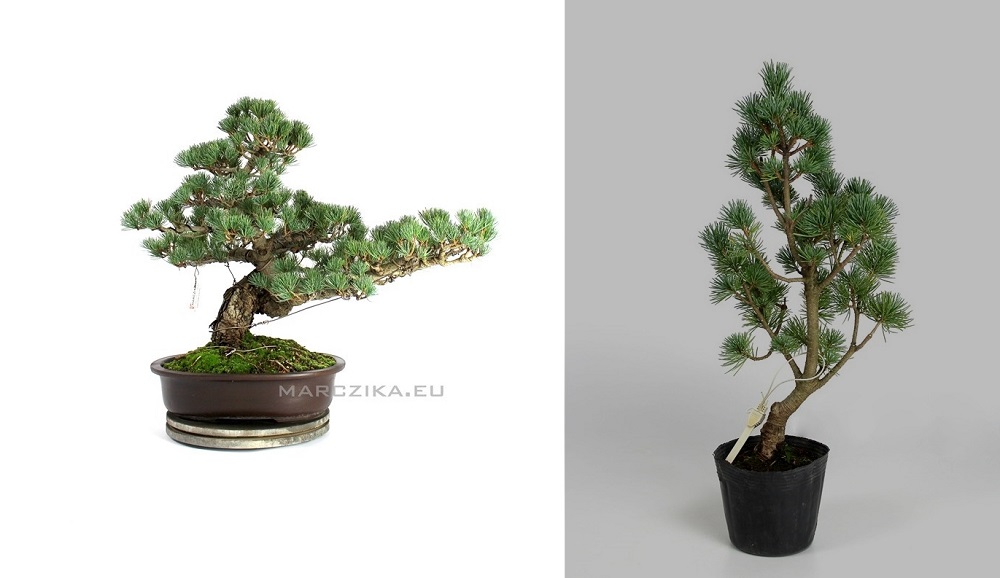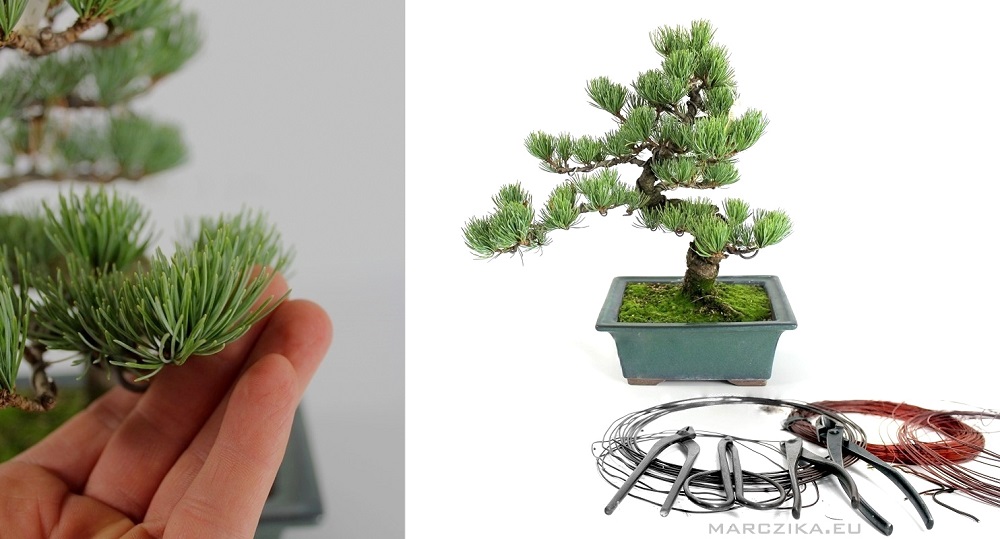Growing pine bonsai i.e. Goyomatsu things for you!
Growing pine bonsai i.e. Goyomatsu things for you! Whether raw material or prebonsai, bonsai or masterpiece bonsai, you will technically have the same thing with these pine bonsai which have the Latin name Pinus parviflora. Japanese white pine, which belongs to the group of five-pin pines, is the most sought-after and coveted bonsai ingredient - yet it is not necessarily easy to obtain at home. It’s not necessarily easy to look for a nice or ungrafted raw material. If we manage to get it, then in many cases questions arise and the natural courage that requires practicality with which we can touch and shape or further grow the plant is lost in some mystical obscurity. There is no rational explanation for why people fear them and how this unwarranted discouragement about them developed. As with other long-needle pines (and really compared to any pine of the genus Pinus), your needs are simple, understandable, and easy to provide. It is worth keeping them in a particularly bright place, and if you have it, then only the trinity of irrigation - soil - nutrients is needed to get a strong plant that can easily withstand the transformations. Before turning to the more important aspects of shaping and upbringing, let’s talk a little bit about keeping Japanese white pines (Goyomatsu).
Keeping and caring for Japanese white pines
Watering and soil selection:
Pine bonsai do not like stagnant wet soil that is constantly soaked and dripping with water. But not the drought. It is especially true for them that although we irrigate them with large doses of water, we never overdo it - even in summer heat. Let's walk the golden mean! Water so that the soil of the pine bonsai can always dry out a little for a short time before the next watering. Knowing that the roots of pines live together so-called. with mycorrhizal fungi, without which the tree would perish. These fungi are destroyed in the denser and constantly dripping soils, they are non-viable and thus endanger and weaken the life of the roots of the pines. This is why it is always worthwhile to use permanently loose soils for transplanting - in which both the mycorrhizal fungi and the roots of the plant feel good. If you want to be sure of your soil choice, use a mixture of Akadama and Kiryu by adding a little tiny grain of coal as well. This mixture can remain permanently loose in structure and, thanks to its water balance, is an ideal medium for mycorrhizal fungi as well as for the hairy roots of pines.
Fertilizer:
In the case of pines in particular, the use of fertilizers should be avoided. They accumulate in the soil, break the rhythm of the plant's cyclical resting time with the constantly provoked uprooted state (the plant becomes overworked), the needles elongate, its candles grow, it brings less new buds from the inside - which is hard to achieve anyway, so even so .. A word like a hundred: use natural - preferably - bonsai nutrients! An example of this is Biogold and Abrakas - Aburakazu. These bonsai nutrients were developed in Japan and perhaps should dn't need to mentioned, but they have already been proven there...
Shaping Japanese white pines
When it comes to shaping, that’s always the first question; what do we want to achieve with the plant? Let's line up. Let the first example be when we launch a young rawmaterial on that particular long journey:
Seedling shaping:
There are basically two ways to shape seedlings. If we want to grow larger bonsai, we don't have much to shape. Usually we need a good large growth bowl and take out a maximum of one or two excess branches and - if there is already something to wire on it - align the trunk with wire. If, on the other hand, you want to grow smaller sized (mame or shohin size) bonsai from the plant, you can do so by bending the trunk and wiring one or two branches - since there is literally not much to wire on a seedling. Pruning is more interesting - in the case of pines, it means some degree of branch thinning rather than shoot formation by pruning. Spring bud bursts or bud cuttings are also important to them and it is worth taking action in time. It will be due to this that the branches will not stretch, but within a few years the young plant will have a richer canopy.
Young pre bonsai shaping
Specifically grown for pre bonsai, Pinus parviflora rawmaterials are most often an option for bonsai lovers with a somewhat bent strain and many branches. In their case, there are few possibilities to change the arc of the trunk - rather, the possibilities lie in shaping and selecting the branches. Before we cut into shaping them, we have a chance to change the nature of the tree. Changing the implantation angle in the bowl can even designate a specific bonsai style. For example, a strong decision can define a cascade or semi-cascade character, a vertical planting angle a Moyogi style, or a non-completely vertical planting bunjin style, etc ... If you have this first phase of the idea, you can come to focus on the branches. You may want to start by simply cutting out branches in weak or bad places that will be redundant (say with a bonsai branch cutter). It is worth taking care to remove anything from the top of the canopy only carefully, because if sometimes with a little cheating but it is necessary to fold something green so that the tree does not look like a balding person. It is a common shaping error that not enough green parts reach the top of the tree. If this happens, we will have a hard time in the long run to grow this deficit with the tree - even if the pines are top dominance. When wiring, keep in mind that the ends of each branch should be gently sloping upwards. Partly because this way we can achieve a more natural effect but most of all because this way the bud gets enough light and so it certainly won’t die for next year.
Shaping older pre bonsai from Japanese white pines
The situation is similar for older prebonsais than for young pre-bonsai. Of course, the difference is there and not just aesthetics. On the one hand, the aesthetic difference is manifested in the spectacular trunks and formed rustic crusts, and on the other hand, the distance of each branch from the trunk is different. This is why aesthetic differences are accompanied by differences that have a practical effect. For example, the thicker branches of older pre bonsai can be shaped well and are not weakened by stronger bends - as opposed to bending thicker branches of younger pre bonsai. Here, too, it is worth noting that the first one or two shapes do not necessarily radically thin out the canopy, because this way we can delay the development of the plant and, moreover, the overall picture will be poorer than we want for a longer period of time. For older pine bonsai, the principle of cascading always works - whether it’s wiring or a complete reshaping of the canopy.
|
ALWAYS WORK CLEANLY! Bonsai repottings are natural to go hand in hand with a little dirt on the ground. Sometimes it’s fussy to even start cleaning up the repotting battlefield at the end of the day. A practical tool for this problem is the bonsai planting tray! Click on the picture to see it! |



.JPG)
.JPG)
.JPG)
.JPG)
.JPG)

.JPG)




0 hozzászólás